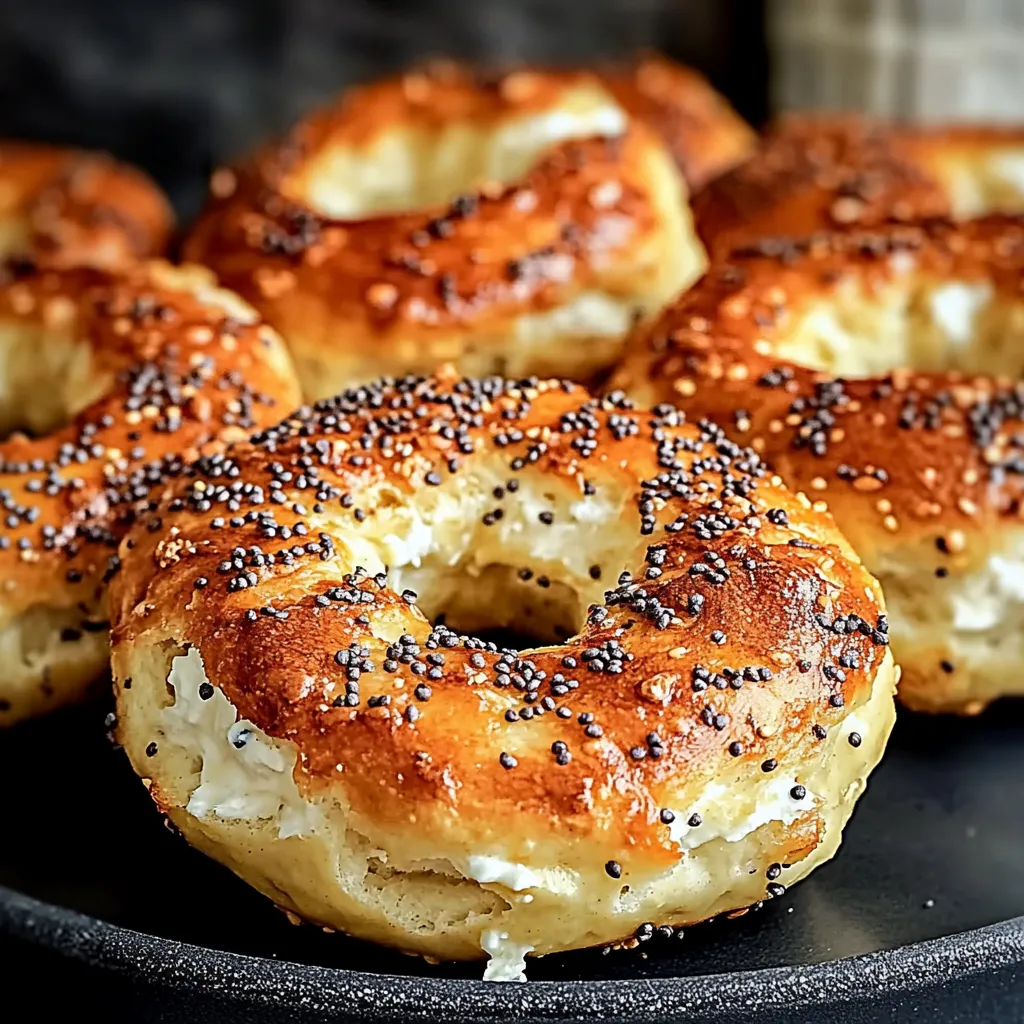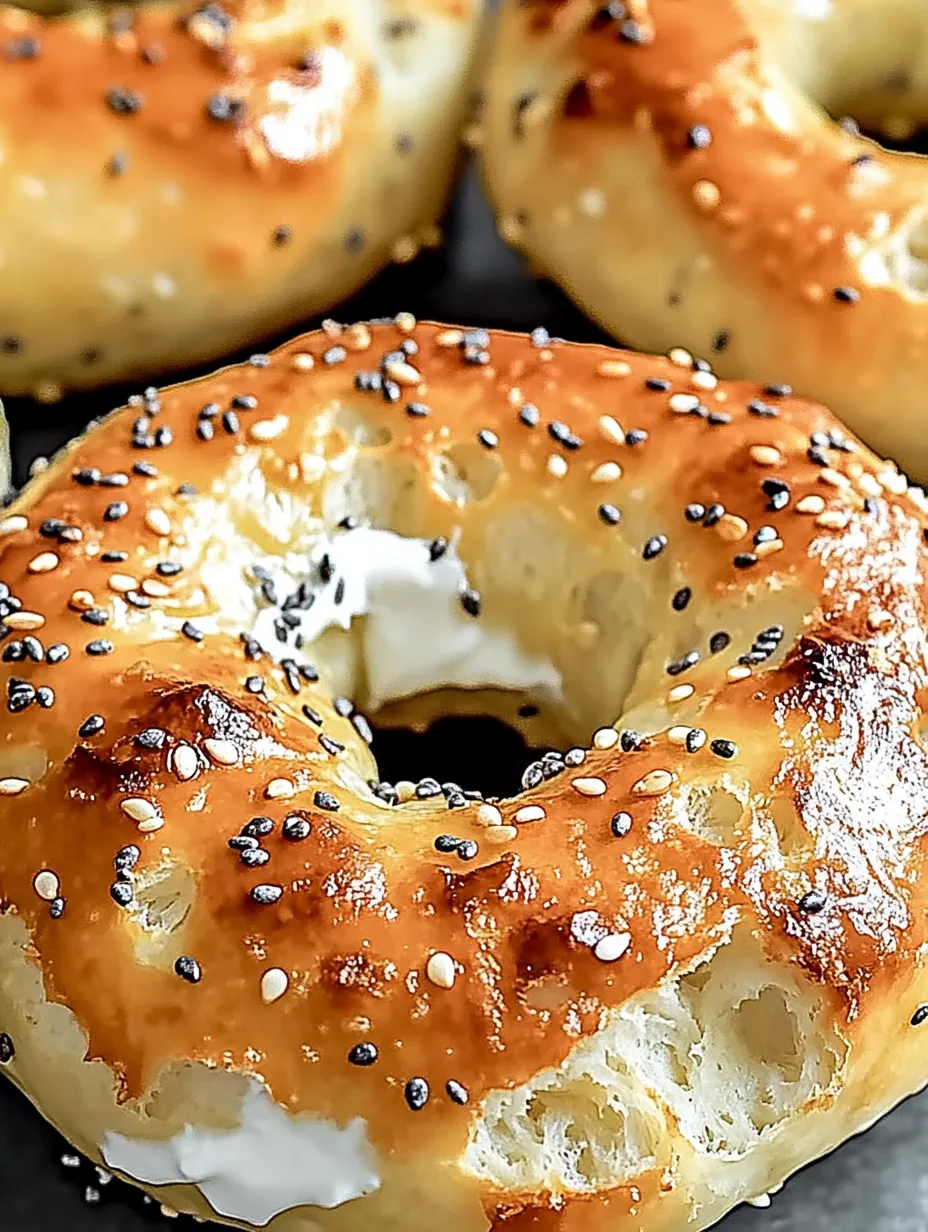 Save
Save
This Greek yogurt bagel recipe transforms a bakery favorite into a quick, high-protein homemade treat that's perfect for busy mornings. The magic happens with just a few ingredients and absolutely no yeast, making these bagels accessible even for novice bakers.
I discovered this recipe during a snowstorm when I couldn't make it to my favorite bagel shop. Now my family requests these bagels almost weekly, especially before busy workdays when we need satisfying, protein-packed breakfasts.
Ingredients
- All purpose flour provides the perfect structure. For a nutrition boost, whole wheat flour works beautifully as a substitute.
- Baking powder creates the rise without yeast, ensuring fluffy bagels every time.
- Salt enhances all the flavors. Always use kosher or sea salt for best results.
- Greek yogurt adds protein and creates moist, tender bagels. Choose the thickest, highest protein Greek yogurt you can find.
- Egg creates that golden, glossy finish when brushed on top before baking.
- Optional toppings allow endless customization. Everything bagel seasoning gives authentic bagel shop flavor.
Step-by-Step Instructions
- Preheat and Prep:
- Set your oven to 400°F while lining a baking sheet with parchment paper. This temperature creates the perfect environment for developing that characteristic chewy bagel texture while ensuring the center cooks through.
- Mix Dry Ingredients:
- Thoroughly whisk together your flour, baking powder, and salt in a large bowl. This even distribution ensures consistent texture throughout your bagels. For cinnamon bagels, adding 2 teaspoons of cinnamon at this stage infuses the entire dough with warm, sweet flavor.
- Incorporate Yogurt:
- Add the Greek yogurt to your dry mixture, first stirring with a spatula until roughly combined. Then use your hands to fully incorporate everything, pressing and folding until no dry spots remain. The dough will feel slightly sticky but should hold together well.
- Shape the Bagels:
- Lightly dust your counter with flour to prevent sticking. Divide your dough into four equal portions by weight if possible. Roll each into a smooth ball between your palms, then gently flatten. Create the signature bagel hole either by pressing your thumb through the center and widening gradually, or by rolling into a log and connecting the ends.
- Egg Wash and Toppings:
- Whisk your egg in a small bowl until smooth, then brush this generously over each bagel. This creates a beautiful golden crust and helps toppings adhere. Apply your chosen toppings immediately while the egg wash is still wet.
- Bake:
- Place your bagels on the prepared baking sheet with at least an inch between them. Bake for 22 to 25 minutes, rotating the pan halfway through for even browning. Look for a deep golden color and firm exterior that feels solid when tapped.
- Cool and Serve:
- Allow the bagels to cool for at least 10 minutes before slicing. This resting period lets the texture set properly and prevents gumminess when cut.
 Save
Save
The Greek yogurt is truly the star ingredient here. I once tried substituting regular yogurt in a pinch and the dough was far too wet. The thickness of Greek yogurt provides both the moisture and structure these bagels need, plus it adds that subtle tangy flavor reminiscent of sourdough.
Troubleshooting Tips
Sticky dough can be the biggest challenge with this recipe. If your yogurt is particularly wet, you might need up to ¼ cup additional flour. Add it gradually, just a tablespoon at a time, until the dough feels tacky but not sticky to the touch. Different brands of Greek yogurt vary significantly in moisture content.
The bagels might look slightly underdone when you remove them from the oven due to the yogurt content, but resist the urge to overbake them. They continue to firm up as they cool. If you cut into them too soon, they may seem doughy inside even when properly baked.
For perfectly round bagels, I recommend weighing your dough portions. Aim for approximately 3 ounces per bagel for consistent size and baking time. This small extra step makes a big difference in the final appearance.
Flavor Variations
Sweet versions work beautifully with this versatile dough. Try folding in ½ cup chocolate chips and a tablespoon of sugar for chocolate chip bagels. Cinnamon raisin lovers can add 2 teaspoons of cinnamon and ⅓ cup of plumped raisins to the dough.
Savory bagels shine with additions like shredded cheddar and jalapeño mixed right into the dough. Another favorite combination is roasted garlic and rosemary kneaded in before shaping. The mild base dough provides the perfect canvas for these bold flavors.
For an everything bagel that rivals your favorite bagel shop, make your own seasoning blend with poppy seeds, sesame seeds, dried garlic, dried onion, and coarse salt. Apply generously after the egg wash for that authentic bagel shop experience.
Storage and Serving
These bagels maintain their texture best when stored in an airtight container. They remain fresh at room temperature for about 2 days. For longer storage, refrigerate for up to a week, though the texture will become slightly denser.
Freezing works exceptionally well for longer storage. Slice the completely cooled bagels before freezing, then place in a freezer bag with parchment between each bagel. Thaw at room temperature or toast from frozen for a quick breakfast.
For serving, these protein-packed bagels make an excellent foundation for both sweet and savory toppings. Try cream cheese with smoked salmon and capers for a classic approach, or almond butter with sliced banana for a nutritious breakfast that will keep you satisfied until lunch.
 Save
Save
Recipe FAQs
- → Can I use whole wheat flour instead of all-purpose flour?
Yes! The recipe specifically mentions you can substitute whole wheat flour for all-purpose flour. This will give your bagels a nuttier flavor and boost their fiber content, though they may be slightly denser in texture.
- → Why is thick Greek yogurt recommended?
Thick Greek yogurt provides the right consistency for the dough to form properly. Regular yogurt or thinner Greek yogurt varieties contain more moisture, which may make your dough too sticky and difficult to work with. If using a thinner yogurt, you might need to add more flour to compensate.
- → What should I do if my dough is too sticky?
If your dough feels too sticky to work with, gradually sprinkle in small amounts of extra flour while kneading until it reaches a manageable consistency. Be careful not to add too much flour at once, as this can make your bagels dry and dense.
- → How do I best store these bagels?
These bagels can be stored at room temperature for up to 2 days in an airtight container. For longer storage, keep them in the refrigerator for up to a week. They also freeze well for up to 2 months - just thaw at room temperature or toast directly from frozen.
- → Can I make sweet versions of these bagels?
Absolutely! For sweet variations, try adding cinnamon to the dry ingredients as suggested in the recipe. You could also incorporate chocolate chips into the dough or top with a cinnamon-sugar mixture before baking. For a dessert-like option, consider adding vanilla extract to the dough and topping with a light glaze after baking.
- → What's the best way to reheat these bagels?
For the best texture when reheating, slice the bagels and toast them in a toaster or toaster oven. If you prefer a softer texture, you can microwave them briefly (10-15 seconds) or warm them in a 350°F oven for about 5 minutes. Toasting generally yields the best results, especially for bagels that have been refrigerated or frozen.
